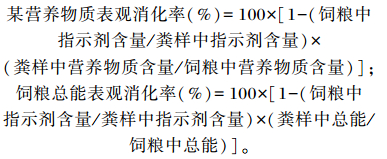磷是动物必需的矿物元素,参与机体能量代谢,促进机体对营养物质吸收,也是生物膜上磷脂的重要组成成分,还是核酸和酶的重要结构成分[1]。有研究表明,鱼类肝脏、胰腺和肠道中胰蛋白酶、脂肪酶和淀粉酶活性与水质中总磷含量呈正相关[2]。Xie等[3]报道,饲粮磷水平显著影响幼建鲤肠道形态以及肠道中胰蛋白酶、脂肪酶、淀粉酶活性。Emami等[4]研究表明,低磷水平显著降低肉鸡对饲粮粗蛋白质和粗脂肪的消化率。Paiva等[5]则报道,低磷水平显著影响肉鸡肠道形态结构。由此可知,磷可促进鱼类肠道对营养物质的消化吸收及肉鸡肠道形态发育和营养物质的消化率。而有研究表明,饲粮中60%~80%的植酸磷不能被家禽利用[6-7],因此在饲粮配制时往往需要添加非植酸磷(non-phytate phosphorus,NPP)。我国是肉鸭养殖量最多的国家,占全球的74.3%[8]。但目前尚不清楚饲粮NPP水平与肉鸭生长性能和消化功能的关系。因此,本研究拟从肉鸭消化器官指数、肠道形态、消化酶活性和营养物质消化率等方面考察饲粮NPP水平对肉鸭生长性能和消化功能的影响,为肉鸭饲粮中磷的适宜添加水平及高效利用提供参考。
1 材料与方法 1.1 试验设计采用单因子试验设计,选取768只体重相近的1日龄樱桃谷肉公鸭,随机分为6个组,每组8个重复,每个重复16只鸭。以磷酸氢钙为磷源,磷添加水平分别为0.1%、0.2%、0.3%、0.4%、0.5%和0.6%,相应的饲粮NPP水平分别为0.24%、0.34%、0.44%、0.54%、0.64%和0.74%。试验期为35 d。
1.2 试验饲粮及饲养管理试验饲粮参照NRC(1994)和《肉鸭饲养标准》(NY/T 2122—2012)配制,基础饲粮主要由玉米和豆粕组成,饲粮配制分为2个阶段,分别为1~14日龄和15~35日龄,基础饲粮组成及营养水平见表 1。各组饲粮中除NPP水平外,其余营养水平均保持一致,各组饲粮中钙水平均为1.00%。肉鸭全程采用网上养殖,试验过程中连续光照,自由采食和饮水。其他饲养管理按照肉鸭常规饲养管理进行。
|
|
表 1 基础饲粮组成及营养水平(风干基础) Table 1 Composition and nutrient levels of basal diets (air-dry basis) |
饲粮样品:试验前,收集各组饲粮500 g,-20 ℃冰箱保存待测。
粪尿样品:肉鸭32~34日龄,分别收集各重复无羽毛皮屑干净排泄物,每次收集称重后按照每100 g鲜样重立即加入10%稀盐酸10 mL混匀进行固氮,每天收集2次,共收集3 d。按重复将排泄物混匀,-20 ℃冰箱保存待测。
35日龄采样:每个重复选取1只该重复平均体重±100 g试验鸭,颈静脉放血致死,采集肝脏、胰腺、十二指肠、空肠、回肠、肌胃和腺胃,并称重,测量肠段长度;取胰腺中间部位相同位置组织样品,十二指肠、空肠、回肠黏膜样品,-80 ℃冰箱保存待测。
1.3.2 指标测定生长性能:以重复为单位,记录试验鸭体重、饲粮消耗量,并计算肉鸭平均日增重(ADG)、料重比(F/G)和采食量(FI)。
消化器官指数:依据消化器官重量及长度计算相对重量和肠段相对长度。
肠道形态:取肠道中间部位1~2 cm,经常规脱水,石蜡包埋、切片、苏木精-伊红染色后通过显微镜观察和拍照,并测量绒毛高度和隐窝深度,计算绒隐比。
消化酶活性:测量胰腺淀粉酶、脂肪酶和胰蛋白酶及十二指肠、空肠和回肠黏膜中麦芽糖酶和碱性磷酸酶(AKP)活性,参照购买的南京建成生物工程研究所相应试剂盒方法测定,步骤参照相应试剂盒说明书。
营养物质表观消化率:采用内源性指示剂法,饲粮及粪样中能量、干物质、粗蛋白质、粗脂肪、钙、磷和盐酸不溶灰分含量分别参照相应国家标准测定。营养物质表观消化率计算公式如下:

|
用SAS 9.2软件对数据进行单因素方差分析(one-way ANOVA),当方差分析显著时,使用Duncan氏法进行多重比较。部分指标进行线性或二次回归分析,表中数据均以平均值±标准误表示,P < 0.05表示差异显著。
2 结果 2.1 饲粮NPP水平对肉鸭生长性能的影响饲粮NPP水平为0.24%时,5日龄时肉鸭开始出现一字腿,头颈歪斜等严重的磷缺乏症,由于肉鸭不能站立,影响采食和饮水,造成肉鸭死亡,14日龄时,肉鸭死亡率达44.53%,因此本文未做相应数据统计。
由表 2可知,随着饲粮NPP水平增加,肉鸭体重、ADG和FI呈线性或二次曲线增加(P < 0.05),0.54%组肉鸭14、35日龄体重及1~14日龄、15~35日龄ADG和FI均显著高于0.34%组(P < 0.05),0.54%组1~14日龄肉鸭F/G显著低于0.34%组(P < 0.05)。
|
|
表 2 饲粮NPP水平对肉鸭生长性能的影响 Table 2 Effects of dietary NPP level on growth performance of meat ducks |
由表 3可知,0.54%、0.64%组肉鸭胰腺绝对重量显著高于0.34%、0.74%组(P < 0.05),0.34%组肉鸭肌胃绝对重量显著低于0.44%、0.54%、0.64%组(P < 0.05)。0.34%组肉鸭肝脏相对重量显著高于其他各组(P < 0.05),0.64%组肉鸭肌胃相对重量显著高于0.74%组(P < 0.05)。
|
|
表 3 饲粮NPP水平对35日龄肉鸭肝脏、胰腺、肌胃和腺胃重量的影响 Table 3 Effects of dietary NPP level on weights of live, pancreas, muscular stomach and glandular stomach of meat ducks at 35 days of age |
由表 4可知,随着饲粮NPP水平增加,肉鸭空肠绝对重量逐渐增加,0.74%组肉鸭空肠绝对重量显著高于0.34%组(P < 0.05),0.64%组肉鸭回肠绝对重量显著高于0.34%组(P < 0.05)。0.44%组肉鸭十二指肠相对重量显著低于0.34%组(P < 0.05)。0.64%组肉鸭十二指肠绝对长度显著高于0.44%组(P < 0.05)。0.34%组十二指肠、空肠、回肠相对长度均显著高于其他各组(P < 0.05)。
|
|
表 4 饲粮NPP水平对35日龄肉鸭肠道重量和长度的影响 Table 4 Effects of dietary NPP level on intestinal weight and length of meat ducks at 35 days of age |
由表 5可知,0.34%、0.54%组肉鸭十二指肠绒毛高度显著低于其他各组(P < 0.05),0.34%、0.74%组肉鸭空肠绒毛高度显著低于其他各组(P < 0.05),0.34%组肉鸭回肠绒毛高度显著低于其他各组(P < 0.05),且0.44%组十二指肠、空肠和回肠绒毛高度显著高于其他各组(P < 0.05)。0.34%、0.44%组肉鸭十二指肠隐窝深度显著低于其他各组(P < 0.05),0.64%组肉鸭空肠隐窝深度显著高于其他各组(P < 0.05),0.34%组肉鸭回肠隐窝深度显著低于其他各组(P < 0.05)。0.44%组肉鸭十二指肠、回肠绒隐比显著高于其他各组(P < 0.05),0.44%、0.54%组空肠绒隐比显著高于其他各组(P < 0.05)。
|
|
表 5 饲粮NPP水平对35日龄肉鸭肠道形态的影响 Table 5 Effects of dietary NPP level on intestinal morphology of meat ducks at 35 days of age |
由表 6可知,随着饲粮NPP水平增加,肉鸭胰腺淀粉酶、脂肪酶、胰蛋白酶活性先增加后降低,0.44%组肉鸭胰腺淀粉酶、胰蛋白酶活性显著高于其他各组(P < 0.05),0.44%组肉鸭胰腺脂肪酶活性显著高于0.34%组(P < 0.05)。0.34%组肉鸭十二指肠黏膜中AKP活性显著高于0.44%、0.74%组(P < 0.05),0.34%组肉鸭空肠黏膜中AKP活性显著高于其他各组(P < 0.05),0.44%组肉鸭回肠黏膜中麦芽糖酶活性显著高于0.34%、0.54%组(P < 0.05)。
|
|
表 6 饲粮NPP水平对35日龄肉鸭胰腺和肠道消化酶活性的影响 Table 6 Effects of dietary NPP level on pancreas and intestinal digestive enzyme activities of meat ducks at 35 days of age |
由表 7可知,0.54%组肉鸭总能、干物质和粗蛋白质表观消化率最高,显著高于0.34%组(P < 0.05)。0.54%、0.74%组肉鸭粗脂肪表观消化率显著高于0.34%组(P < 0.05)。0.34%、0.44%组肉鸭钙表观消化率显著低于其他各组(P < 0.05)。0.34%组肉鸭总磷表观消化率显著低于其他各组(P < 0.05)。
|
|
表 7 饲粮NPP水平对肉鸭营养物质表观消化率的影响 Table 7 Effects of dietary NPP level on nutrient apparent digestibilities of meat ducks |
Rodehutscord等[9]研究发现,饲粮可利用磷水平为0.18%时,肉鸭在1周龄出现严重磷缺乏症。而早期Lin等[10]研究结果表明,饲粮总磷水平为0.45%时,肉鸭没有出现缺乏症。本试验结果表明,饲粮NPP水平为0.24%时,肉鸭出现严重的磷缺乏症,导致肉鸭饮水和采食困难。研究表明,随着饲粮磷水平增加,肉鸭体重、体增重、ADG和FI逐渐增加[9-11]。本试验结果表明,随着饲粮NPP水平增加,肉鸭体重、ADG和FI先逐渐增加再降低。有研究表明,饲粮中可利用磷水平为0.76%时,肉鸭体增重达到最大值[10]。本试验结果表明,饲粮NPP水平为0.54%时,肉鸭生长性能最佳。依据本文研究结果,实际生产中适宜的提高饲粮NPP水平能改善肉鸭生长性能。
3.2 饲粮NPP水平对肉鸭消化功能的影响研究表明,动物消化器官中含量最高的矿物元素为磷[12]。有学者指出,低磷水平显著降低鱼类肝胰腺重量、肝体指数、肠重和肠长[3]。本试验结果表明,饲粮NPP水平显著影响35日龄肉鸭胰腺和肌胃绝对重量。贾慧君[13]研究表明,随着饲粮NPP水平增加,肉鸡十二指肠、空肠和回肠绝对重量呈二次增加,回肠相对重量显著增加。本试验结果表明,饲粮NPP水平显著影响35日龄肉鸭空肠和回肠绝对重量和十二指肠相对重量。本试验还发现,饲粮NPP水平显著影响35日龄肉鸭十二指肠绝对长度和十二指肠、空肠和回肠相对长度。由此可知,饲粮NPP水平能影响肉鸭消化器官发育。
肠道被誉为动物体的“第二大脑”,是动物吸收各种营养物质的主要场所,因此肠道的健康与否是影响动物生长性能一个关键因素[14]。研究发现,磷不仅仅是机体的组成成分,还具有维持肠道形态功能的作用[15]。有研究报道,饲喂低磷饲粮有降低仔猪肠道绒毛高度、隐窝深度和绒隐比的趋势,显著降低回肠绒毛高度[16]。饲喂低磷饲粮可降低肉鸡肠道绒毛高度和绒隐比[4-5]。本试验结果表明,饲粮NPP水平显著影响35日龄肉鸭十二指肠、空肠和回肠绒毛高度、隐窝深度和绒隐比,当饲粮NPP水平为0.44%时达到最大值。由此可知,磷能通过改善肉鸭肠道形态结构,从而提高肉鸭肠道对营养物质的消化吸收能力。
有研究发现,饲粮磷水平可显著影响鱼类肠道消化酶活性,如胰蛋白酶、脂肪酶和淀粉酶等[3]。本研究发现,饲粮NPP水平显著影响肉鸭胰腺淀粉酶、脂肪酶、胰蛋白酶及回肠麦芽糖酶活性,当饲粮NPP水平为0.44%时达到最大值。Motzok等[17]研究结果表明,0.16%无机磷组肉鸡肠道AKP活性显著高于0.48%无机磷组。本试验研究发现,0.34%组十二指肠、空肠黏膜中AKP活性最高。以上研究结果表明,适宜的饲粮NPP水平能增强肉鸭肠道消化酶活性。
3.3 饲粮NPP水平对肉鸭营养物质表观消化率的影响不同动物对饲粮中磷的表观利用率不同,且不同磷源对动物磷的表观利用率也有影响[18]。Potchanakorn等[19]研究表明,肉鸡对不同磷源利用率不同。那么磷水平不同是否会影响动物对其他营养物质的消化率呢?本试验结果表明,饲粮NPP水平对肉鸭各营养物质表观消化率均有显著影响。Emami等[4]研究发现,饲喂低磷水平饲粮,肉鸡对干物质表观消化率没有显著影响,显著降低粗蛋白质和粗脂肪表观消化率。代述均[20]研究也指出,低磷水平饲粮显著降低肉鸭总能、干物质和粗蛋白质表观消化率,与本试验结果一致。本试验结果表明,饲粮NPP水平为0.54%时,肉鸭营养物质表观消化率达到最大值。由此可知,饲粮NPP水平能影响肉鸭对营养物质表观消化率,低NPP水平饲粮可降低肉鸭营养物质表观消化率。
4 结论在本试验条件下,饲粮NPP水平为0.54%时,肉鸭生长性能达到最佳,且适宜的饲粮NPP水平能通过改善肉鸭消化器官指数、肠道形态及增强消化酶活性来改善肉鸭的消化功能和提高肉鸭对营养物质的消化吸收。
| [1] |
BERNDT T, KUMAR R. Novel mechanisms in the regulation of phosphorus homeostasis[J]. Physiology, 2009, 24(1): 17-25. DOI:10.1152/physiol.00034.2008 |
| [2] |
黄瑾, 熊邦喜, 陈洁, 等. 鱼类消化酶活性与体长、体重和水质的相关性研究[J]. 水生态学杂志, 2012, 33(2): 121-126. |
| [3] |
XIE N B, FENG L, LIU Y, et al. Growth, body composition, intestinal enzyme activities and microflora of juvenile Jian carp (Cyprinus carpio var. Jian) fed graded levels of dietary phosphorus[J]. Aquaculture Nutrition, 2011, 17(6): 645-656. DOI:10.1111/j.1365-2095.2011.00867.x |
| [4] |
EMAMI N, ZAFARI NAEINI S, RUIZ-FERIA C A. Growth performance, digestibility, immune response and intestinal morphology of male broilers fed phosphorus deficient diets supplemented with microbial phytase and organic acids[J]. Livestock Science, 2013, 157(2/3): 506-513. |
| [5] |
PAIVA D, WALK C, MCELROY A. Dietary calcium, phosphorus, and phytase effects on bird performance, intestinal morphology, mineral digestibility, and bone ash during a natural necrotic enteritis episode[J]. Poultry Science, 2014, 93(11): 2752-2762. DOI:10.3382/ps.2014-04148 |
| [6] |
刘宏, 刘国华, 陈娴. 不同植酸磷水平饲粮中添加植酸酶对肉鸭生长性能和血清生化指标的影响[J]. 动物营养学报, 2010, 22(4): 1063-1070. DOI:10.3969/j.issn.1006-267x.2010.04.037 |
| [7] |
REDDY N R, SATHE S K, SALUNKHE D K. Phytates in legumes and cereals[J]. Advances in Food Research, 1982, 28: 1-92. DOI:10.1016/S0065-2628(08)60110-X |
| [8] |
侯水生. 2018年度水禽产业发展现状、未来发展趋势与建议[J]. 中国畜牧杂志, 2019, 55(3): 124-128. |
| [9] |
RODEHUTSCORD M, TIMMLER R, WENDT P. Response of growing Pekin ducks to supplementation of monobasic calcium phosphate to low-phosphorus diets[J]. Poultry Science, 2003, 82(2): 309-319. DOI:10.1093/ps/82.2.309 |
| [10] |
LIN I M, SHEN T F. Studies on duck nutrition.Ⅱ.Calcium and phosphorus requirements of mule ducklings[J]. Poultry Science, 1979, 58(1): 124-130. DOI:10.3382/ps.0580124 |
| [11] |
FARIDI A, GITOEE A, FRANCE J. A meta-analysis of the effects of nonphytate phosphorus on broiler performance and tibia ash concentration[J]. Poultry Science, 2015, 94(11): 2753-2762. DOI:10.3382/ps/pev280 |
| [12] |
SCHWARZ F J, HEINDL U, KIRCHGESSNER M. Content and deposition of major mineral elements in different tissues and empty body of growing bulls of the german simmental breed[J]. Archiv für Tierernaehrung, 1995, 48(1/2): 183-199. |
| [13] |
贾慧君.饲粮非植酸磷水平对1~21 d肉鸡生产性能、免疫功能及肠道微生物的影响[D].雅安: 四川农业大学, 2018.
|
| [14] |
AL-BAHRANI A Z, DARWISH A, HAMZA N, et al. Gut barrier dysfunction in critically ill surgical patients with abdominal compartment syndrome[J]. Pancreas, 2010, 39(7): 1064-1069. DOI:10.1097/MPA.0b013e3181da8d51 |
| [15] |
HEYER C M E, WEISS E, SCHMUCKER S, et al. The impact of phosphorus on the immune system and the intestinal microbiota with special focus on the pig[J]. Nutrition Research Reviews, 2015, 28(1): 67-82. DOI:10.1017/S0954422415000049 |
| [16] |
SHIELDS M C.Effect of phytase on growth performance, proteolytic enzyme activity, and gut morphology in weaned pigs[D].Ph.D.Thesis.North Carolina: North Carolina State University, 2013.
|
| [17] |
MOTZOK I, RITCEY G M, DAVIES M I. Effect of dietary calcium, phosphorus, and vitamin D3 on alkaline phosphatase activity of intestinal mucosa of chicks[J]. Canadian Journal of Physiology and Pharmacology, 1971, 49(4): 338-344. DOI:10.1139/y71-037 |
| [18] |
RODEHUTSCORD M, DIECKMANN A. Comparative studies with three-week-old chickens, turkeys, ducks, and quails on the response in phosphorus utilization to a supplementation of monobasic calcium phosphate[J]. Poultry Science, 2005, 84(8): 1252-1260. DOI:10.1093/ps/84.8.1252 |
| [19] |
POTCHANAKORN M, POTTER L M. Biological values of phosphorus from various sources for young turkeys[J]. Poultry Science, 1987, 66(3): 505-513. DOI:10.3382/ps.0660505 |
| [20] |
代述均.饲粮非植酸磷水平对肉鸭生产性能、盲肠微生物及胫骨质量的影响[D].硕士学位论文.雅安: 四川农业大学, 2017.
|




